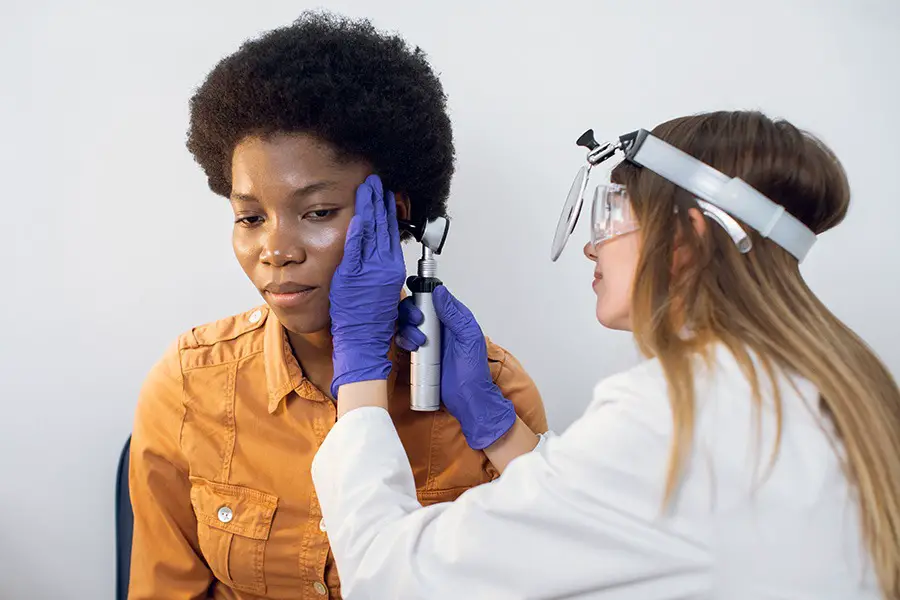Introduction
Embracing parenthood introduces a plethora of emotions, experiences, and queries, one of which may relate to ‘sensorineural hearing loss’. If this term has recently entered your lexicon, seeking comprehensible explanations is expected. Grasping sensorineural hearing loss is paramount not only for parents whose children have been diagnosed but also for individuals striving to stay knowledgeable. This exhaustive guide will delve into sensorineural hearing loss, its implications, and how it may affect your child. By the conclusion, you will be armed with a wealth of information and strategies to optimally support your child through their distinctive journey.
What Is Sensorineural Hearing Loss?
An Initial Insight Sensorineural hearing loss represents a kind of hearing impairment arising from damage to the inner ear or the neural pathways from the inner ear to the brain. This is the most prevalent form of irreversible hearing loss and generally cannot be rectified medically or surgically.
Hearing is a sophisticated process that commences when sound waves infiltrate the outer ear and journey through the ear canal, striking the eardrum. These waves induce the eardrum to vibrate, passing these vibrations onto the minuscule bones within the middle ear. These bones augment the sound vibrations and transmit them into the inner ear or cochlea, which houses tiny hair cells that react to these vibrations by generating an electrical signal. This signal is subsequently dispatched to the brain via the auditory nerve, which decodes it into sound.
Sensorineural hearing loss can transpire when there’s dysfunction or harm to the inner ear or auditory nerve. This implies that the route traveled by sound waves to be decoded as sound is obstructed, culminating in hearing loss.
Sensorineural vs. Conductive Hearing Loss
The Fundamental Dissimilarities The human auditory system can suffer from disparate types of hearing loss – sensorineural and conductive. In contrast to sensorineural hearing loss, conductive hearing loss transpires when a difficulty arises in transmitting sound waves along the pathway traversing the outer ear, tympanic membrane (eardrum), or middle ear (ossicles). This can be attributed to obstructions, fluid buildup, or abnormalities in the ear structures.
Even though both types of hearing loss culminate in a diminished capacity to hear, their causes and treatments significantly differ. Conductive hearing loss is typically transitory and can be rectified through medical or surgical intervention. Conversely, sensorineural hearing loss is generally permanent. Although it cannot be reversed, it can be managed effectively via hearing aids, cochlear implants, and other assistive technologies.
An In-depth Examination of the Ear’s Anatomy
Our hearing ability hinges on the intricate workings of the ear, which is divided into three primary parts: the outer ear, the middle ear, and the inner ear.
The outer ear comprises the pinna (the visible part of the ear) and the ear canal. Its main function is to guide sound waves via the ear canal to the eardrum. The middle ear, hosting the eardrum and three minuscule bones known as ossicles, amplifies the vibrations incited by the sound waves hitting the eardrum and conveys them to the inner ear.
The inner ear, the site of sensorineural hearing loss, encompasses the cochlea and the auditory nerve. The cochlea is inundated with fluid and lined with thousands of tiny hair cells. As the sound vibrations reach the cochlea, the fluid ripples, moving the hair cells. As these hair cells move, they generate electrical signals which are then transmitted to the brain via the auditory nerve.
Damage occurring in the inner ear or along the auditory nerve—such as from aging, loud noise exposure, or certain medications—can result in sensorineural hearing loss. This is because the transmission of sound signals from the cochlea to the brain is disrupted.
OTC Hearing Aid Pair
Experience the world like never before with the RCA OTC Behind-the-Ear Hearing Aid. Our advanced digital technology ensures that every sound is crystal clear and vibrant, allowing you to fully immerse yourself in life’s experiences. Whether it’s the laughter of loved ones or the music that moves you, our hearing aid brings back the joy of every moment.
Say goodbye to the hassle of appointments and prescriptions. The RCA OTC Hearing Aid is designed to meet the needs of individuals without the need for a prescription. With its seamless setup and user-friendly design, you can effortlessly enhance your hearing abilities and stay connected to the world around you. Simply unpack, wear, and enjoy improved auditory perception instantly.
Experience optimal comfort and style with our discreet behind-the-ear design. The thin tube design allows you to wear glasses comfortably, so you can enjoy clear hearing while maintaining your personal sense of style. Plus, our rechargeable battery ensures long-lasting power, eliminating the inconvenience of constantly replacing small batteries. Elevate your hearing experience with the RCA OTC Hearing Aid and embrace the world with confidence.
Sensorineural Hearing Loss: Origins from Genetics to Noise
Sensorineural hearing loss can have a multitude of causes, the most common being aging. As we grow older, the hair cells in our cochlea naturally deteriorate and lose their ability to send signals to the brain, leading to age-related sensorineural hearing loss.
Prolonged exposure to loud noises can also cause sensorineural hearing loss. Loud noises can harm or obliterate the hair cells in the cochlea. Unlike certain body cells, these hair cells do not regenerate, so any damage is permanent. Constant exposure to loud music or working in a noisy environment such as a construction site can amplify the risk of sensorineural hearing loss.
Genetic factors can also contribute to sensorineural hearing loss. Specific genetic mutations can increase an individual’s susceptibility to hearing loss. The Connexin 26 gene mutation serves as one of the most common genetic origins of non-syndromic hearing loss.
Diseases like Meniere’s disease or autoimmune diseases can also lead to sensorineural hearing loss. Furthermore, certain medications, termed ototoxic drugs, can inflict damage on the inner ear and cause sensorineural hearing loss. Some chemotherapy drugs, aminoglycoside antibiotics, and large amounts of aspirin are examples of ototoxic drugs.
Sensorineural Hearing Loss: Signs to Be Aware Of
Recognizing the symptoms of sensorineural hearing loss can facilitate early intervention, which is vital for managing the condition. Sensorineural hearing loss can manifest in several ways.
Your child may struggle to hear soft sounds or decipher speech, especially amidst background noise. They might frequently request others to repeat themselves or elevate the volume on the TV or radio. Certain sounds may appear overly loud or distorted, and they may have trouble distinguishing high-pitched sounds (like “s” or “th”) from each other.
Sensorineural hearing loss may also provoke changes in a child’s academic performance or behavior. They might appear inattentive or struggle to follow instructions. This is because they are straining to hear, which can be taxing and affect their concentration and behavior.
Diagnosing Sensorineural Hearing Loss:
What Does the Procedure Entail? When sensorineural hearing loss is suspected, the initial step involves visiting a healthcare provider or audiologist. They will likely commence by inquiring about the individual’s medical history and performing a physical examination. This examination can exclude any problems in the outer or middle ear, like a buildup of wax or fluid, which could be inducing temporary hearing loss.
Subsequently, a series of hearing tests may be conducted. These tests can identify the type and degree of hearing loss. A common test is the pure-tone audiometry test, where the individual listens to a variety of sounds at different tones and volumes. This test can help determine the faintest sound a person can hear at different frequencies.
In certain cases, additional tests may be required to identify the exact cause of the hearing loss. These might include imaging tests like a CT or MRI scan, which can provide detailed images of the inner ear and auditory nerve.
Early diagnosis of sensorineural hearing loss is crucial. It permits early intervention, which can significantly enhance a child’s ability to communicate and their overall life quality.
Conclusion
Understanding sensorineural hearing loss can be a daunting journey for any parent, but bear in mind, you’re not alone. With the insights from this guide, you are now prepared to navigate this journey armed with knowledge and confidence.
We’ve investigated the complex anatomy of the ear and the path sound waves take to reach our brain. We’ve probed the causes of sensorineural hearing loss, from age and loud noises to genetics and certain medications. We also discussed the signs to monitor, which can range from difficulty hearing soft sounds to alterations in academic performance or behavior.
Remember, early detection is paramount in managing sensorineural hearing loss. If your child exhibits any of the mentioned symptoms, don’t hesitate to seek professional advice. Numerous resources and technologies are available to aid children with hearing loss live a fulfilling and successful life.
In this era of incessant information flow, it’s essential to stay informed, particularly when it pertains to the welfare of our children. By understanding sensorineural hearing loss, we can better advocate for them and ensure they receive the necessary care and support.

Decoding Silence: An Analytical View on the Advances in Conductive Hearing Loss Research and Treatment
This analytical article sheds light on conductive hearing loss, offering an in-depth exploration of its genetic factors, treatment advances, and promising experimental therapies.

Embracing the Melody of Life: Navigating the Journey with Conductive Hearing Loss
A blog post delving into the experiences and challenges of living with conductive hearing loss, discussing its impact on everyday life, social interactions, mental health, and the potential benefits of hearing aids and cochlear implants.





